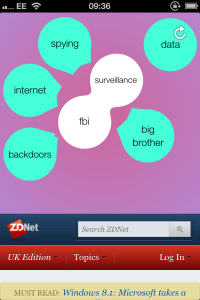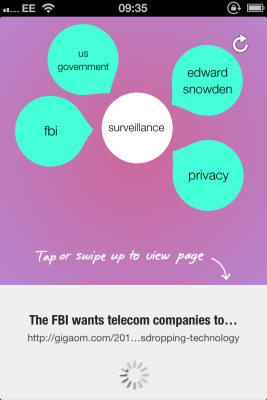Helsinki, Finland-based smarter web surfing startup Futureful, which launched in the U.S. on iPad back in January — and is best described as a predictive discovery engine (rather than a traditional web browser) — has extended its reach, launching onto the iPhone with a global app. The startup has raised around $1.5 million to-date. Its main investor is Skype (and Kazaa) co-founder Janus Friis.
The earlier U.S.- and iPad-only launch was a “test-run”, says co-founder Jarno Koponen, aimed at seeing how its machine learning tech managed out in the wild. It also wanted to see how users took to its interface/UX — which dispenses with URL bars, and other traditional browsing paraphernalia, to focus on encouraging curiosity and serendipity. As part of that test run, Futureful has now updated its interface — dispensing with the original discovery ticker and opting for a new bubbles-based browsing mechanism instead.
The new interface — introduced in the iPhone app but also now pushed out to the iPad app too — focuses on dynamic browsing bubbles which contain topic words, and are used to bubble content up at the user. The user taps on a bubble to dive into a particular topic, bringing in a swarm of related bubbles. So, for instance, a bubble containing the word  ‘surveillance’ might (currently) bring up others containing the words ‘NSA’ and ‘Edward Snowden’.
‘surveillance’ might (currently) bring up others containing the words ‘NSA’ and ‘Edward Snowden’.
In-topic bubbles can then be combined to make a search even more specific — effectively creating a visual version of the ‘+’ search engine function, while also giving the user visual cues about relevant addition terms to incorporate into their search. Articles that match the current search combination/bubble conglomeration appear at the bottom of the iPhone app, accessible via a swipe.
“Bubbles provide a way to freely explore things, you can choose one particular thing or you can combine it with something. There’s no linear connection but the connection that every individual sees. And every individual sees different connections even in the same set of topics,” says Koponen, explaining the thinking behind the design. “Also, the experience is peaceful. You can do things in your own time. Pick up things where you left them but at the same time be sure that there’s something new for you. You never end up in the same place twice.”
It’s not the first time I’ve seen bubbles as a visual method to encourage discovery. For instance, back in April, vitamin and health food online retailer Vitacost launched a tablet-optimised website for the iPad and iPad Mini that included “browsing bubbles” to displayed related info and products to encourage online shoppers to discover new things as they browse.
Futureful’s bubbles are more sophisticated than Vitacost’s, being as they can be combined in different ways, but it’s interesting to see the same visual metaphor cropping up when the underlying aim is to introduce more serendipity into the digital sphere. The filter bubble concept — which argues that traditional search engines are narrowing a user’s view of information online because search results become increasingly tailored to their past and social preferences — is doubtless informing design here.
Futureful doesn’t have a sign in process (although it uses iCloud to link your iPad and iPhone usage) or any social feeds powering which content it bubbles up. Rather it relies on AI, semantic tagging and machine learning — aka it tracks everything you do — meaning it will learn more about you as you use it. But it also has built-in mechanisms to avoid becoming its own version of the Google filter bubble. Basically since it knows what you look at, it also knows what you haven’t/don’t — so can push that stuff at you too.
“We encourage discovery by making web surfing a fluid and endless personal journey,” adds Koponen. “Bubbles invite you to touch them. When you’ve chosen your first topic, we offer you alternatives i.e. your every choice matters and directs the journey. The app learns from your every interaction. We’re not trying to give you one perfect answer but a set of interesting alternatives i.e. we encourage you to explore and go beyond what you already know. To support discovery, the journey is not linear — you can jump to different directions (e.g. by combining “art” and “nanotechnology”) or you can continue with related topics (e.g. “art” and “abstract paintings”).”
The initial bubbles that appear in the app are “based on hot topics” and also on what concurrent users of the system are doing — so akin to Twitter’s trending feature. After that, the app tracks all your choices to feed its algorithm, as well as looking at other users’ patterns of choices to add “likely patterns” from their profiles to yours to try to predict topics of interest for you.
Koponen says it avoids the filter bubble effect by presenting multiple topic choices — both those with strong connections and those with “serendipitous” connections. “We don’t provide you one single answer, but provide you both strongly connected topics as well as topics with more serendipitous connection and allow you to choose. We avoid “filter-bubble” by providing you also topics that you and your similar users/concurrent users don’t share,” he says.
“A simplified example: you and you similar user share topics “technology”, “travel”, “design”. We look what topics the similar user has and you don’t have, and provide you a selection of those “not-shared” topics to introduce you new possible connections. This enables us to provide new alternatives, things that you’re potentially interested in.”
Futureful is not breaking out downloads or user numbers as yet, noting that it has been concentrating on optimising its user experience thus far. Its staggered launch this year has been part of that — allowing it to test how its “non-session-based, context-specific fluid experience” flies, and evidently decide that a new bubbles-based user interface was a better idea than a topic ticker.
For now Futureful remains iOS only but an Android version of the app is planned, possibly for the end of this year says Koponen.
